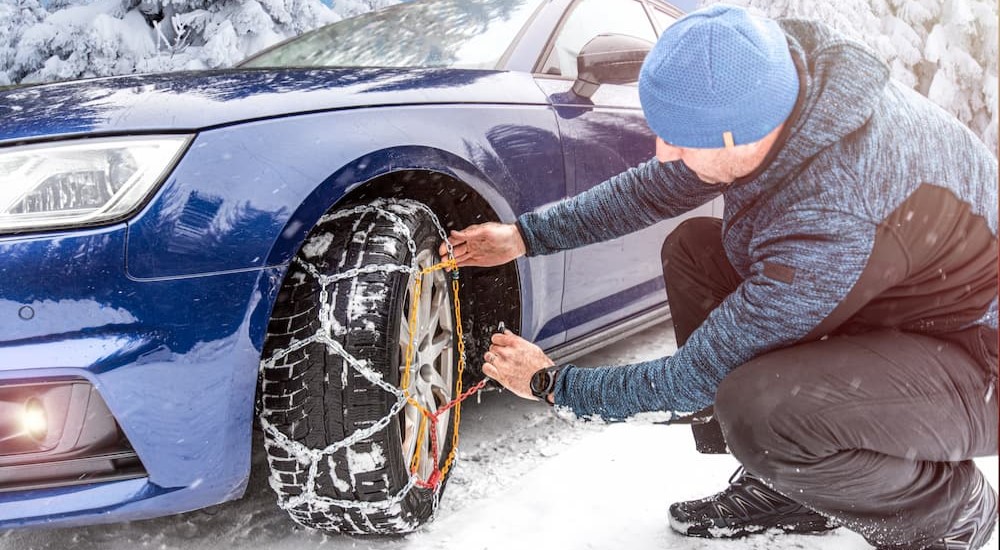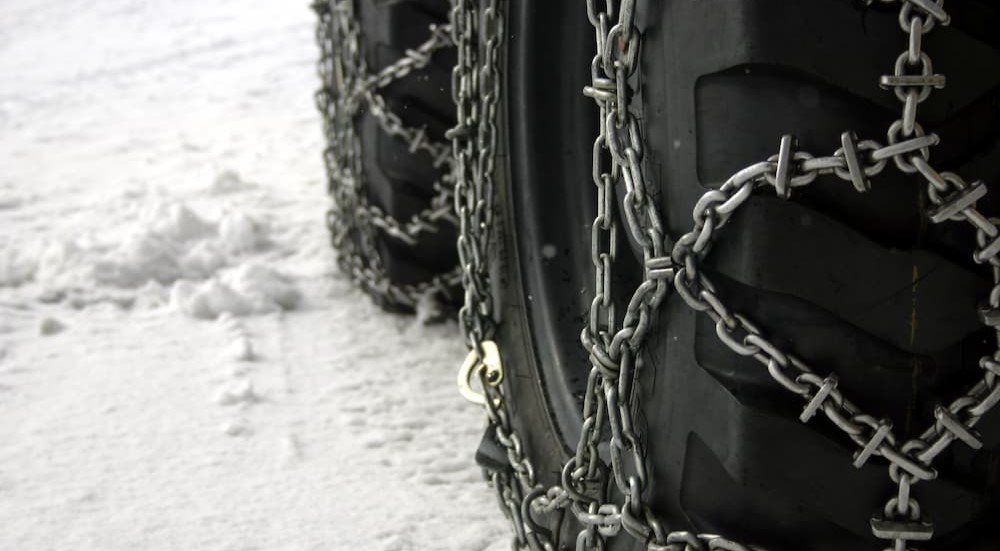If you want to improve your vehicle’s traction in tough winter conditions, you have two options. The first is switching out your regular all-season tires for a set of snow tires. This annual rite of passage might make sense for those living in the colder reaches of the country, but for those who are less familiar with the ravages of Old Man Winter, tire chains might be a more sensible option. Priced at a fraction of what a set of snow tires might cost and easy to install and uninstall on the fly, tire chains can give any car, truck, or SUV the extra traction it needs to deal with the occasional blizzard or ice storm. If you’re tired of slipping across the road when the white stuff starts to fall but aren’t ready to invest in a set of dedicated snow tires, tire chains might be the perfect solution. Read on as we discuss the difference between tire chains and snow tires, outline some of the pros and cons of tire chains, and examine some of the different designs that are available on the market today.
Tire Chains vs. Snow Tires
Tire chains are simply a set of metal chains that drivers can temporarily attach to their tires when facing ice, snow, and other challenging road conditions. Tire chains provide a little extra traction, preventing slippage and eliminating the sort of wheelspin that one might encounter when the roads start to ice over. Tire chains come in all shapes and sizes, but generally, they look like a metal ladder or lattice when laid out on the ground. While it’s important to pick the right size and style for your specific vehicle, the rest of the installation process is fairly simple and doesn’t require any specialized tools. Tire chains are a great alternative to snow tires for drivers who rarely find themselves navigating winter weather. In some mountainous states, they are even required by law to cross certain passes during the winter. However, it’s important to remember that they’re just a short-term solution.
Snow tires are built from a type of specialized rubber that stays flexible in cold weather. They are designed with a deeper, wider tread pattern that can chew through the snow and effectively channel water and road slush away from the wheels. Snow tires can go a long way toward improving any vehicle’s cold-weather performance. If regular snow tires aren’t up to the task, there are always studded snow tires. These are virtually identical to regular snow tires, with the exception of metal studs embedded within the tread. Studded snow tires can claw right into ice to provide unbeatable grip, but this aggressive approach can be a liability when it comes to comfort, noise, and fuel economy. Studded snow tires are even banned in some areas due to their detrimental effect on the road surface, so it’s always best to check up on any local laws or ordinances before making your purchase.
Tire Chain Pros
Tire chains offer several advantages over a dedicated set of snow tires, especially if you encounter snow and ice only occasionally.
Price
Affordability is one of the main selling points of tire chains. Compared to snow tires, which can easily run a driver anywhere between $500 and $800 for a set of four, tire chains are a relative bargain at $100 to $250 for a set. That said, it’s usually a good idea to read through the reviews and stay away from some of the cheaper options on the market. It might seem like a good way to save a couple of bucks, but when you’re talking about something as serious as road safety, it’s probably worth the splurge.
Installation
Tire chains can be easily installed by any driver who has enough time and patience to learn the correct procedure. With a little practice, a set of tire chains can be slapped onto a vehicle in just a few minutes, whether in the comfort of your own driveway or stuck on the side of the road in the middle of a harsh winter storm. This starkly contrasts snow tires, which typically need to be installed and uninstalled at the beginning and end of each winter. Some enterprising drivers could save money by mounting snow tires to a second set of wheels and performing the switchover themselves, but regardless of whether you embrace the professional or DIY route, snow tire installation is a lot more involved than simply outfitting your vehicle with a set of tire chains.
Portability
A full set of tire chains can be easily stored in the trunk, cargo bed, or even under the seats. This portability means you can take tire chains with you wherever you go, safe in the knowledge that you’ll be prepared should a winter storm roll in. If you’re planning a cross-country road trip that involves passing through a snowy or mountainous area, the chains can be installed at a moment’s notice. Snow tires aren’t nearly as compact and not a practical investment if you live in a more temperate climate, but tire chains are a different story altogether.

Tire Chain Cons
As with anything, tire chains have both advantages and disadvantages. Here are some of the downsides of tire chains.
Noise and Comfort
Tire chains might be a convenient alternative to snow tires, but that convenience does come at a cost. Tire chains always provide a rougher, louder ride than snow tires. Since tire chains are typically only installed for a short amount of time, drivers might be able to live with a little extra noise or discomfort, but they can also make for a less-than-peaceful driving experience.
Damage
If not properly installed, tire chains can damage the tires, wheels, or even a vehicle’s bodywork around the wheel wells. This can usually be avoided by following all the installation instructions and ensuring a tight fit, but if the chains should break off while driving, there’s no telling what sort of harm they might cause.
Fuel Economy
Vehicles weren’t designed to operate with a set of metal chains attached to each tire, so you can expect your EPA-estimated fuel economy to take a nosedive when using tire chains. There’s no beating the sort of traction they can offer, but they are not environmentally friendly.
Legality
In addition to damaging your vehicle, tire chains can also damage the road. This is part of why tire chains, especially the studded variety, are restricted or banned in some areas. Your state might limit when and where tire chains can be used, so it’s always a good idea to do a quick internet search and make sure your effort to add a little traction doesn’t land you on the wrong side of the law.
Speed
When driving with tire chains, most experts recommend keeping your speed below 25 to 30 mph. Start moving any faster, and the chains not only become less effective, but they also run the risk of breaking off and damaging your vehicle or other cars on the road. No matter how bad the road might be, using tire chains at highway speeds is never a good idea.
Limited Use
Due to their noise, discomfort, and potential for damage, tire chains aren’t a good long-term solution for dealing with ice and snow. Tire chains should only be employed as a temporary fix and never be treated as a replacement for a good set of winter tires.

Types of Tire Chains
Tire chains come in a variety of styles, from basic link chains and V-bar chains to those employing a diamond, square, or studded design. Each type offers its own unique advantages and disadvantages, so let’s take a closer look and see which variety might be the best fit for your driving needs.
Link Chains
Link chains represent the most popular and adaptable option on the market. They might be based on a relatively simple design, but they’re also affordable, very easy to attach, and can be installed on a wide range of vehicles and tires. However, link chains do have a few drawbacks. They create a relatively noisy ride, impact comfort on paved roads, and do not provide quite as much bite as some of the more heavy-duty options on the list.
V-Bar Chains
V-Bar chains are essentially an enhanced version of the link chain design. These chains include a V-shaped stud or bar welded onto each link, improving traction and allowing vehicles to handle some of the toughest winter conditions. Great for ice or densely packed snow, V-bar chains can help a driver claw up a steep incline while providing more stability and control than some other chain types. On the downside, the V-bar design can also leave a lasting mark on the road and cause a lot of noise and uncomfortable vibrations when they’re in use. Drivers also need to take care to properly install V-bar chains, as a mistake could cause damage to the tire itself.
Diamond Chains
Diamond chains are similar to link chains but feature a diamond-shaped pattern that offers some significant advantages in terms of traction. Ideal for loose, uneven surfaces like ice, snow, and mud, diamond chains improve traction in every direction. These properties have made diamond chains the go-to choice for those who enjoy a little off-road adventure, but they don’t hold up quite as well when it comes to steep hills, thick ice, and other extreme weather conditions.
Square Link Chains
Square link chains are a variation of basic link chains but with a few important differences. First, the links in the chain tend to be larger and use a squared-off design instead of the rounded design of a basic link chain. These square links are better at digging into snow, ice, and rock, delivering optimal traction at the cost of comfort. Square link chains are also more durable than regular link chains, but they’re also heavier and need to be installed correctly if you’re hoping to avoid long-term damage to your tires or wheel wells.
Studded Chains
When link, V-bar, diamond, and square link chains won’t do, it’s time to turn to studded chains. As the name implies, these chains feature studs or spikes that protrude from the links, providing top-tier grip and keeping your vehicle steady on even the most slippery road. Studded chains can’t be beat in terms of stability and control, but their aggressive design does have some disadvantages. Studded chains are so likely to cause road damage that they’re actually banned in some areas and generally not recommended for use on roads that have already been cleared of snow and ice. They’re also more expensive than other types of tire chains, but there’s no arguing with their effectiveness.
Tire chains are a convenient, cost-effective alternative to traditional snow tires, but they might not be right for every driver and every driving situation. Before you head to your local auto parts store or favorite online retailer in search of a new set of tire chains, take a moment to consider how often you find yourself dealing with harsh winter weather. If icy roads, plow trucks, and snow days are a relatively rare sight in your area, a set of tire chains might be the perfect way to deal with the occasional storm. If, on the other hand, you know your way around a snowblower and have a few buckets of road salt stashed away in your garage, chances are snow tires are a more practical option.

